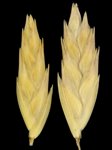
T. pungens spikelets.
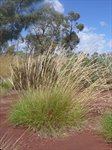
T. pungens habitat.
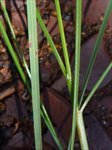
T. pungens leaves.
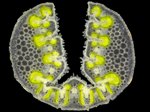
T. pungens leaf setion.
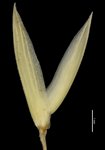
T. pungens glumes.
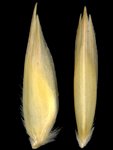
T. pungens lemmas.

T. pungens paleas.

T. pungens map.

T. pungens (left) and T. epactia (right) comparison; note difference in lemma lobe length and angle.
Name
Triodia pungens R.Br.
Citation
Prodr. 182 (1810)
Derivation
pungens — from Latin pungens, pungent, referring to the sharp leaf tips.Common name
Soft Spinifex
Synonyms
None relating to the Pilbara form
Diagnostic features
Foliage resinous; leaf sheaths glabrous; leaves epistomatous; spikelets with >3 florets; lower glume 4.2–7.2 mm long, broadly lanceolate or ovate to oblong, L:W 1.7–4, 3–11-nerved; lemmas shortly lobed and not awned, the lobes erect and ± appressed, not recurving in age, body texture ±uniform, lacking a dorsal ‘hump’ in profile, membranous margins present or not; lowest lemma midlobe 0.6–1.5 mm long; paleas winged, glabrous; distribution in the eastern part of the Hamersley Range, east of Wittenoom and the central Karijini National Park, north to the Fortescue River.
Habitat
Occurs on a variety of substrates, from rocky summits and slopes, gorges and cliffs, to red loam flats and sandy plains.
Distribution and frequency
Widespread in central Australia. In the Pilbara occurs only in the eastern part of the Hamersley Range, east of Wittenoom and the central Karijini National Park, north to the Fortescue River. Very common within its range.
Similar species
Triodia pungens belongs to the Soft group, sharing the epistomatous (soft-type) leaf blades.
Triodia pungens has been widely confused with T. epactia in the past, and the two species are very similar; the exact species boundaries remain to be resolved. The following discussion of differences only applies to Pilbara forms of T. pungens. The Pilbara variant of Triodia pungens is extremely similar to T. epactia. Other than by their non-overlapping but complementary distribution (see below under Identification without florets), the two species can only be distinguished by the following features:
T. epactia: Lemma lobes (1.2–)1.5–5 mm long, from anthesis the lobes distinctly ascending-spreading, divergent from each other and the spikelet outline; margin of lateral lemma lobes prominently winged laterally; body of lemma conspicuously indurated, thicker and more yellow than ± membranous lobes, ± bitextured, fully mature lemmas in profile having a distinct ‘hump’ in outline due to the abrupt change in lemma thickness.
T. pungens: Lemma lobes short, 0.6–1.5 mm long, appressed to the next lemma or almost so, and not or scarcely diverging from each other even in age; margin of lateral lemma lobes not winged or prominently winged laterally; body of lemma indurated, but grading more gradually into membranous margins, not or only weakly bitextured (or sometimes more strongly bitextured), in profile the outline smoothly curved and lacking a distinct ‘hump’.
The only other Pilbara species with epistomatous leaves and non-awned lemmas are T. biflora, T. karijini and T. veniciae. Triodia biflora has only two obvious florets (plus a third minute floret requiring dissection to see) and only minute lemma lobes <0.5 mm long (more than 4 florets and with short but distinct lemma lobes 0.6–1.5 mm long in T. pungens).
Triodia karijini and T. veniciae have narrowly lanceolate glumes (L:W≥5) and very narrowly-acute lemma lobes with midlobe 2–3.2 mm long (glumes broadly lanceolate, oblong to ovate with L:W4 and lemma lobes broadly acute to narrowly acute and 0.6–1.5 mm long in T. pungens). Furthermore, T. karijini has non-resinous foliage and T. veniciae has sparsely to moderately hairy leaf sheath surfaces (resinous foliage and glabrous leaf sheath surfaces in T. pungens).
Conservation status
Not considered at risk.
Identification without florets
Specimens of T. pungens lacking florets can be distinguished form all species except T. biflora by the combination of distribution in the eastern Hamersley and southern Fortescue sub-regions, resinous foliage and broadly lanceolate or oblong to ovate glumes (L:W4). Three other species with resinous foliage in and around the eastern Hamersley sub-region (T. melvillei, T. schinzii, T. sp. Mt Ella) have narrowly lanceolate glumes (L:W≥5). Triodia biflora has similar resinous foliage and broad glumes to T. pungens but can be distinguished by having small glumes 2.5–3.5 mm long (4.2–7.2 mm long in T. pungens). Rare specimens of T. pungens with minimal and overlooked resin might be mistaken for T. karijini, but the latter species has tightly-clumping tussocks (forming loose hummocks in T. pungens) and narrowly lanceolate glumes (L:W≥5) compared to broadly lanceolate or oblong to ovate glumes (L:W4) in T. pungens.
Triodia epactia is very similar to T. pungens. Without florets, T. epactia can only be distinguished from T. pungens using distribution; the two species have complementary distributions, but never approach more than about 10 km from each other. Although T. epactia occurs throughout most of the Pilbara and surrounds, it is absent from the eastern Hamersley Range and Little Sandy Desert. Triodia epactia is replaced by T. pungens from Karijini National Park and Wittenoom east, and south of the Fortescue River bed along the Fortescue Valley.
Variation
A relatively uniform species.
Notes
The relationships and non-Pilbara distribution of Triodia pungens remain uncertain. Triodia pungens as treated by Lazarides (1997) and Lazarides et al. (2005) appears to be a polyphyletic species complex (see multiple positions of T. pungens in trees in Toon et al. 2015). The Pilbara form of “T. pungens” appears to be much closer to T. epactia than true T. pungens of arid north Queensland and the Northern Territory. The Pilbara form of Triodia pungens appears to extend east of the Pilbara into the Little Sandy Desert, but the relationships with T. pungens sensu stricto closer to the WA border are uncertain. Further genetic and morphological studies are needed.
The species concept and characteristics of T. pungens used here covers only Pilbara specimens referred to T. pungens by Lazarides (1997), Lazarides et al. (2005) and Ausgrass (Sharp & Simon, 2002; Simon & Alonso, 2014), however maps presented therein are inaccurate since they incorporated many sterile specimens misclassified under T. epactia. The species descriptions of T. pungens in the aforementioned references are almost entirely based on non-Pilbara specimens, and should not be used for the Pilbara.
A full description specifically of the Pilbara form of T. pungens is not yet available; measurements used in SpiKey are based only on Pilbara specimens.
Young plants are palatable to stock.
Resprouting behavior not known for Pilbara forms.